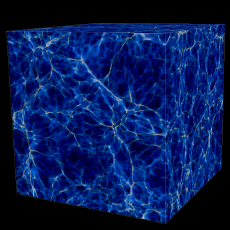About
The Thermal State of the InterGalactic Medium
As the universe evolves, the balance between cooling due to Hubble expansion and inverse-Compton scattering of cosmic microwave background photons and heating due to the gravitational collapse and photoionization heating give rise to a well-defined temperature–density relationship in the InterGalactic Medium: T=T0 Δγ-1 where Δ is the overdensity with respect to the mean and T0 is the temperature at the mean density. Another important physical ingredient to describe the thermal state of the IGM is the gas pressure support. At small scales and high densities, baryons experience pressure forces that prevent them from tracing the collisionless dark matter. This pressure results in an effective 3D smoothing of the baryon distribution relative to the dark matter, at a characteristic scale, known as the Jeans pressure smoothing scale, λP.
The T.H.E.R.M.A.L. Suite
The THERMAL Suite has been built to try to explore the thermal state of the IGM by building a set of models that explore the parameter space of the these 3 thermal parameters and compare them against different observables. The main bulk of the THERMAL Suite consists in more than 60 simulations with different thermal histories on a box size of 20 Mpc/h and 10243 cells based on the same cosmological model consistent with the most recent Cosmic Microwave Background observations from the Planck satellite (Ωm=0.3192, ΩL=0.6808, Ωb=0.04964, h=0.6704, ns=0.96, σ8=0.826). The suite also includes some extra simulations with different cosmological seeds, box size, resolution elements and/or cosmology to provide a reliable test bench for convergence and systematics. For all simulations we save an snapshot for every Δz=0.2 from z=6.0 down to z=1.6, as well as at z=1.0, z=0.5 and z=0.2. The grid of simulations is still expanding.
The Cosmological Hydrodynamical Code: Nyx
All simulations were performed with the public code Nyx developed at the Lawrence Berkeley National Laboratory. The evolution of dark matter in Nyx is calculated by treating dark matter particles as self gravitating Lagrangian particles, while baryons are treated as an ideal gas on a uniform Cartesian grid. Nyx uses a second-order accurate piecewise parabolic method (PPM) to solve for the Eulerian gas dynamics equations, which accurately captures shock waves. The gas is assumed to be of primordial composition with Hydrogen and Helium. All relevant atomic cooling processes, as well as UV photo-heating, are modeled under assumption of ionization equilibrium. Inverse Compton cooling off the microwave background is also taken into account. We used the updated recombination, cooling, collision ionization and dielectric recombination rates from Lukić et al. (2015).
Modeling Different Thermal Histories
As is standard in hydrodynamical simulations that model the IGM and the lyman-α forest, all cells are assumed to be optically thin to radiation. Radiative feedback is accounted for via a spatially uniform, but time-varying ultraviolet background (UVB) radiation field, input to the code as a list of photoionization and photoheating rates that vary with redshift (e.g Katz et al. 1992). We have created a grid of models that explore very different thermal histories combining different methodologies. First we have used the approach presented in Oñorbe et al. (2017), which allows us to vary the timing and duration of reionization, and its associated heat injection, enabling us to simulate a diverse range of reionization histories. This method allows us to create the HI, HeI and HeII photoionization and photoheating rates, which are inputs to the cosmological hydrodynamical codes as Nyx, by volume averaging the photoionization and energy equations. On top of this we also use the methodology first introduced by Bryan & Machacek (2000) of rescaling the photoheating rates by factor, A, as well as making the heating depend on density according to ΔB Becker et al. (2011), where B is also a free parameter and Δ is again, the overdensity with respect to the mean. Combining all these approaches allows us to build a large set of different thermal histories and widely explore the thermal parameter space of T0, γ and λP at different redshifts.
